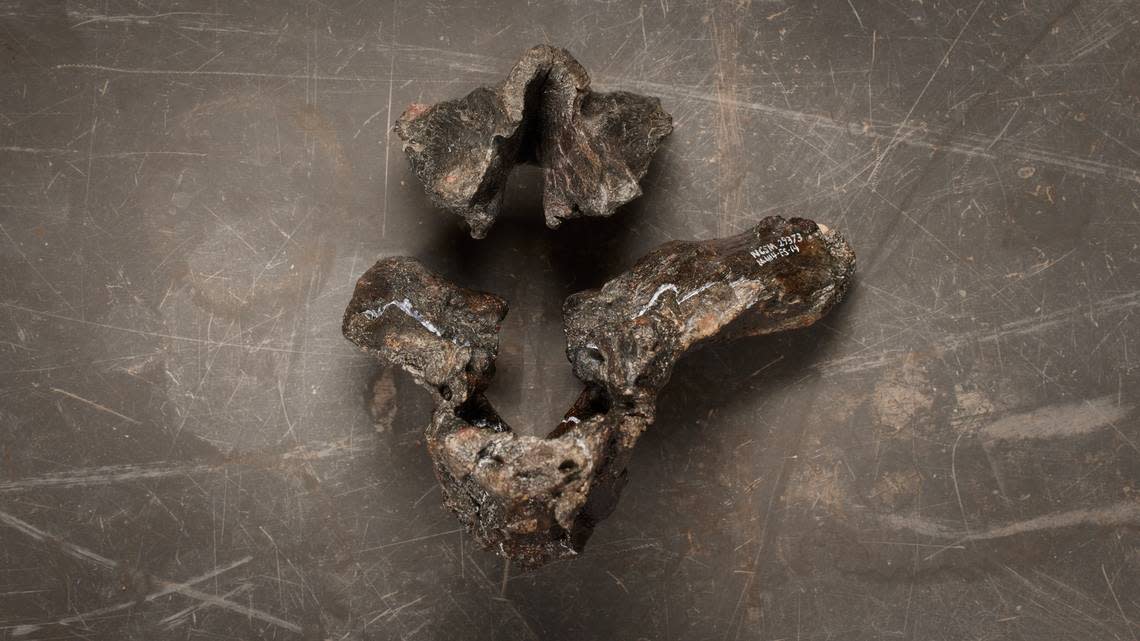NC State team discovers new dinosaur that could provide clues about climate change
A new dinosaur discovered by a team of North Carolina-based paleontologists could provide more information about the history of our planet dating back tens of millions of years, and inform ongoing research about Earth’s changing climate today.
In a research article published Wednesday, paleontologists from N.C. State University, Stellenbosch University in South Africa and the University of Minnesota detail their discovery of Iani smithi, a dinosaur that lived in what is now Utah during the mid-Cretaceous period, approximately 99 million years ago.
The dinosaur, named after Janus, the Roman god of change and transitions, was a plant-eating herbivore with a powerful jaw, N.C. State said in a news release. It is “the single known specimen of this species,” per the research article.
Lindsay Zanno, an associate research professor at N.C. State and the head of paleontology at the North Carolina Museum of Natural Sciences, told The News & Observer Wednesday morning that she and the other paleontologists involved in the discovery found bones belonging to the new dinosaur on a dig at Utah’s Cedar Mountain Formation in 2014.
“We pretty much knew from the moment we found it that it was a new species,” Zanno said. “Nothing like that had really been seen in that area before.”
Species likely witnessed ‘double whammy’ of change
The discovery of I. smithi is unique, in part, because the dinosaur is an early rhabdodontomorph, a lineage of dinosaurs that was previously known to exist almost exclusively in Europe during an earlier time period.
“We definitely weren’t expecting to find something like this at this time period, because the late Cretaceous is usually thought of as a time when you have much more advanced dinosaurs, and Iani’s a much earlier lineage of dinosaur than we were expecting to find,” Zanno said.
The I. smithi species likely witnessed a “double whammy” event leading to the extinction of many dinosaurs that had been living in North America during the mid-Cretaceous, Zanno said, and its experiences could inform research about climate changes Earth is experiencing now.
The Cretaceous period of Earth’s history was one marked by major change to the planet’s climate, with rising global temperatures and sea levels. A land bridge also formed between Asia and North America during the period, Zanno said, introducing new groups of dinosaurs to North America that forced competition, and eventually extinction, among species.
I. smithi could have been the last surviving member of the lineage of dinosaurs that once thrived in North America, but then was overtaken by the new groups, which included “smaller plant eaters, like early duckbills and horned dinosaurs, and feathered theropods like tyrannosaurs and enormous oviraptorosaurs,” N.C. State’s release said.
“What we’re interested in understanding, really, is teasing apart that complex story and understanding how exactly the climate change affected dinosaurs and who went extinct, who survived and why,” Zanno told The N&O, “and what that can teach us as we face these same sort of changes on our planet today.”

Analyzing the skeleton in NC
In the almost 10 years since making their initial discovery of I. smithi, Zanno and her team obtained permits to collect and excavate the dinosaur’s skeleton from its location in Utah, then transported it back to the Museum of Natural Sciences in downtown Raleigh for cleaning and conservation.
The skeleton includes the dinosaur’s vertebrae, limbs and skull, including its distinctive jaw that includes “teeth designed for chewing through tough plant material,” the release from N.C. State said.
“That process takes years to do, to clean every bone, especially when you have a skeleton like this, where you have a lot of surviving parts,” Zanno said.
The process is one Zanno is familiar with, though, as this isn’t the first time she has played a role in discovering new dinosaur species. In 2019, she announced the discovery of Moros intrepidus, a small relative of the much larger Tyrannosaurus rex, and she was also involved in the discovery of a fossilized nest of dinosaur eggs.
Western North America, where I. smithi and many of her other discoveries have been located, is an area that is “very, very poorly understood” when it comes to dinosaurs that may have roamed the area. Most dinosaurs that would have lived in the area “are still unknown to science,” Zanno said, which provides vast opportunities for scientists — and, eventually, young aspiring ones — to make more discoveries.
“Every year that we go out, we’re discovering new species out there and filling in a little more of this story about how climate change impacted dinosaur evolution,” she said.
Zanno said there are not any immediate plans to display the skeleton at the Museum of Natural Sciences due to ongoing preparations for the upcoming Dueling Dinosaurs exhibit, which is expected to open next year.
“After that, we’ll see,” Zanno said of potentially displaying I. smithi at the museum.
